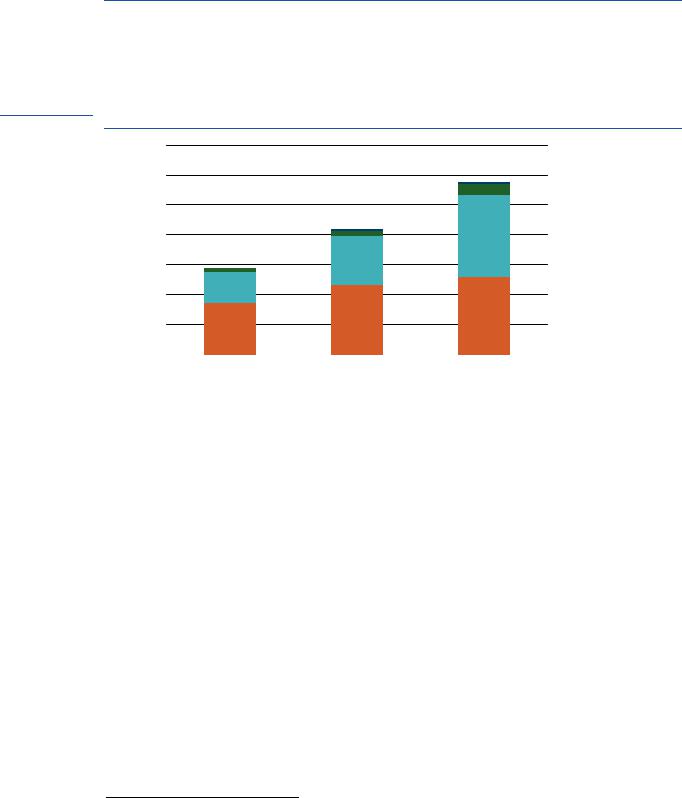
- •Foreword
- •Acknowledgements
- •Table of contents
- •Executive summary
- •Introduction
- •Purpose and scope
- •Structure of the report
- •Definitions
- •Classification of rail transport services
- •Key parameters
- •Data sources
- •References
- •1. Status of rail transport
- •Highlights
- •Introduction
- •Rail transport networks
- •Urban rail network
- •Conventional rail network for passenger and freight services
- •High-speed rail network
- •Rail transport activity
- •Passenger rail
- •Urban rail
- •Conventional and high-speed rail
- •Freight rail
- •What shapes rail transport?
- •Passenger rail
- •Freight rail
- •Rail transport and the energy sector
- •Energy demand from rail transport
- •Energy intensity of rail transport services
- •GHG emissions and local pollutants
- •Well-to-wheel GHG emissions in rail transport
- •Additional emissions: Looking at rail from a life-cycle perspective
- •High-speed rail
- •Urban rail
- •Freight rail
- •Conclusions
- •References
- •Introduction
- •Rail network developments
- •Rail transport activity
- •Passenger rail
- •Urban rail
- •Conventional and high-speed rail
- •Freight rail
- •Implications for energy demand
- •Implications for GHG emissions and local pollutants
- •Direct CO2 emissions
- •Well-to-wheel GHG emissions
- •Emissions of local pollutants
- •References
- •3. High Rail Scenario: Unlocking the Benefits of Rail
- •Highlights
- •Introduction
- •Motivations for increasing the role of rail transport
- •Urban rail
- •Conventional and high-speed rail
- •Freight rail
- •Trends in the High Rail Scenario
- •Main assumptions
- •Rail network developments in the High Rail Scenario
- •Rail transport activity
- •Passenger rail in the High Rail Scenario
- •Urban rail
- •Conventional and high-speed rail
- •Freight rail in the High Rail Scenario
- •Implications for energy demand
- •Implications for GHG emissions and local pollutants
- •Direct CO2 emissions in the High Rail Scenario
- •Well-to-wheel GHG emissions
- •Investment requirements in the High Rail Scenario
- •Fuel expenditure
- •Policy opportunities to promote rail
- •Passenger rail
- •Urban rail
- •Conventional and high-speed rail
- •Freight rail
- •Conclusions
- •4. Focus on India
- •Highlights
- •Introduction
- •Status of rail transport
- •Passenger rail
- •Urban rail
- •Conventional passenger rail
- •High-speed rail
- •Freight rail
- •Dedicated freight corridors
- •Rail transport energy demand and emissions
- •Energy demand from rail transport
- •GHG emissions and local pollutants
- •Outlook for rail to 2050
- •Outlook for rail in the Base Scenario
- •Context
- •Trends in the Base Scenario
- •Passenger rail
- •Freight rail
- •Implications for energy demand
- •Implications for GHG and local pollutant emissions
- •Outlook for rail in the High Rail Scenario
- •Key assumptions
- •Trends in the High Rail Scenario
- •Passenger and freight rail activity
- •Implications for energy demand
- •Implications for GHG and local pollutant emissions
- •Conclusions
- •References
- •Acronyms, abbreviations and units of measure
- •Acronyms and abbreviations
- •Units of measure
- •Glossary

Page | 152
IEA 2019. All rights reserved.
The Future of Rail |
IEA 2019. All rights reserved. |
Opportunities for energy and the environment
emissions in 2050 as compared to a situation in which all rail activity was transferred to road transport.28 In 2050, rail also avoids 8 kt of PM2.5 emissions as compared to a situation in which all rail transport were by road transport.29
Figure 4.12 Well-to-wheel GHG emissions from India’s rail sector in the Base Scenario, 2017, 2030 and 2050
|
70 |
|
|
|
|
|
|
eq |
60 |
|
|
|
|
|
High-speed rail |
|
|
|
|
|
|||
2 |
|
|
|
|
|
|
|
MtCO |
50 |
|
|
|
|
|
|
|
|
|
|
|
|
Metro |
|
|
40 |
|
|
|
|
|
|
|
|
|
|
|
|
||
|
|
|
|
|
|
||
|
|
|
|
|
|
|
|
|
30 |
|
|
|
|
|
Conventional rail |
|
20 |
|
|
|
|
|
|
|
|
|
|
|
|
||
|
|
|
|
|
|
|
|
|
10 |
|
|
|
|
|
Freight rail |
|
|
|
|
|
|
||
|
0 |
|
|
|
|
|
|
|
|
|
|
|
|
|
|
|
|
|
|
|
|
|
|
|
2017 |
2030 |
2050 |
|
|
|
|
Source: IEA (2018a).
Key message • Annual well-to-wheel GHG emissions from rail are projected at more than 57 Mt CO2-eq in 2050.
Outlook for rail in the High Rail Scenario
India’s strong economic growth and rising energy demand in the Base Scenario present a number of wider energy challenges. Total oil demand more than doubles over the next decades as incomes grow and demand for passenger and freight activity rises; transport contributes around 60% to the overall increase in oil demand (IEA, 2018c). These figures have important energy policy implications: India’s oil imports almost triple over the period, despite strong growth in the uptake of electric cars (which account for over 20% of the passenger car stock by 2050 in the Base Scenario) and regulatory efforts to reduce the average fuel consumption of cars and trucks. The environmental toll of transport activity also rises. Besides the growth in GHG emissions, transport also remains an important source of PM2.5, nitrogen oxide (NOX) and sulphur dioxide (SO2) emissions through 2050, even with the successful implementation of Bharat VI standards, which alleviate much of the pollutant emissions in the Base Scenario. These challenges can be addressed by strengthening rail transport. In the following section, the High Rail Scenario (detailed in Chapter 3) is used to explore the potential benefits of such a transition to an increased reliance on rail in India. It considers what kind of changes would need to occur
28 This result is obtained on the assumption that passenger rail would be replaced by aviation, cars, buses and two/three-wheelers, that freight rail would be replaced by heavy freight trucks. The weighted average WTW GHG emission factor of road transport in India in 2050 is 0.05 Mt CO2-equivalent/billion passenger-kilometre. The WTW GHG emission factor of heavy freight trucks in India in 2050 is 0.09 Mt CO2-equivalent/billion tonne-kilometre (IEA, 2018a).
29 This result is obtained on the hypothesis that the activity of passenger rail in 2050 is replaced by passenger light-duty vehicles, two/three-wheelers and buses, each maintaining its modal share, that the activity of freight rail is replaced by heavy freight trucks and using calculated pollutant emission factors for the different modes (IEA, 2016).

IEA 2019. All rights reserved.
IEA 2019. All rights reserved. |
The Future of Rail |
|
Opportunities for energy and the environment |
|
|
in each rail sector and illustrates what impact these could have on key indicators. In addition, it discusses the kinds of policy measures that would be necessary to take the country along this path.
Key assumptions
For India, the High Rail Scenario involves a significant shift of passenger and freight transport Page | 153 from road and aviation to rail. This shift is facilitated by action conducive to rail infrastructure
investment across all types of rail, improvements in the attractiveness of passenger rail services, in particular, and action to increase the competitiveness of rail passenger and freight transport.
For urban rail, the High Rail Scenario assumes that India completes all the metro projects currently under construction and being planned (as in the Base Scenario), and it also fulfils the Union Internationale de Transports Publics (UITP) target of doubling the modal share of urban rail at the expense of private modes of transport (UITP, 2014). The attractiveness of metro travel and, hence, utilisation is increased by generating additional non-tariff revenues in order to keep travel fares low. Capturing land value around the metro stations and developing and taxing commercial activities in the stations are key features (Sharma and Newman, 2017). Beyond the realm of the railway authorities (but of the utmost importance), road vehicle charges and taxes on private vehicles levied based on their environmental performance strengthen the economic competitiveness of rail services.
For conventional rail, limited network capacity is a significant limiting factor on the expansion of the rail business in the Base Scenario (Planning Commission, 2014), so facilitating further network extension is a key assumption in the High Rail Scenario. Action to generate additional sources of revenues, while increasing the attractiveness of passenger services, is another key assumption, making it possible to reduce the dependency of passenger rail services on cross-subsidisation from freight rail. The main pillars of action in the High Rail Scenario are:
•Improving the balance of operational costs and revenues by diversifying the offer of intercity rail services (such as offering overnight connections), through increased utilisation and thereby increasing the competitiveness of rail against car travel and aviation for long-distance trips as a result of achieving higher utilisation rates.
•Differentiated tariffs and services, accounting for the prices of competing modes at different times of the day and for the origin and the destination of trips.
•The increase of non-tariff revenue from rail stations and neighbouring areas through real estate development and land value capture, both for new stations (which should be large
enough to be able to host commercial activities) and existing stations (through refurbishment/ renovation).30
As in the case of metros, road vehicle charges and taxes levied on private vehicles, based on their environmental performance, also strengthen the economic viability of rail investments.
For high-speed rail, this scenario assumes that the success of the MAHSR project (which is also assumed in the Base Scenario) is followed by development of the other high-speed rail lines currently under evaluation, which are the linkages along the Golden Quadrilateral and its two diagonals (Map 4.3). In the High Rail Scenario, policy measures, such as integrating planning of
30 Capturing non-tariff revenue from rail stations is a well-established practice in Japan and other countries. It requires developing commercial and tertiary real estate, taking advantages of the high volumes of people traffic around train stations that raise land value. Although a Rail Land Development Authority in India is tasked to develop land commercially, this aspect of non-tariff revenue earning is currently largely untapped.
